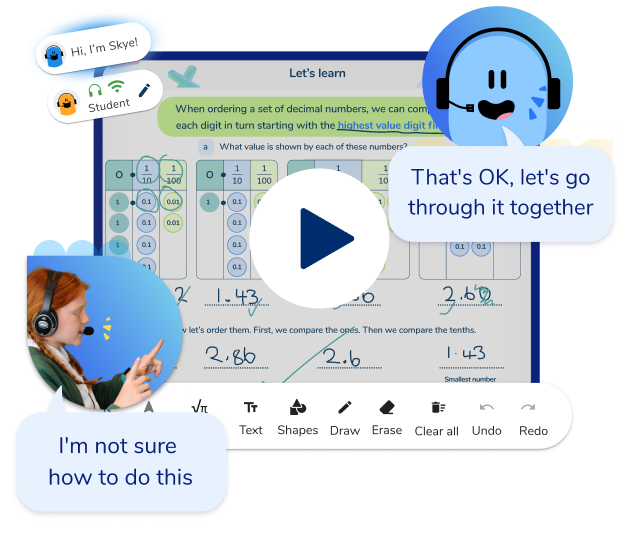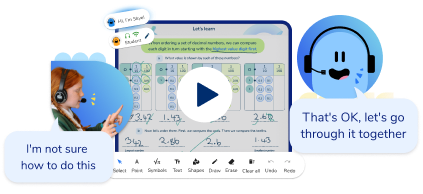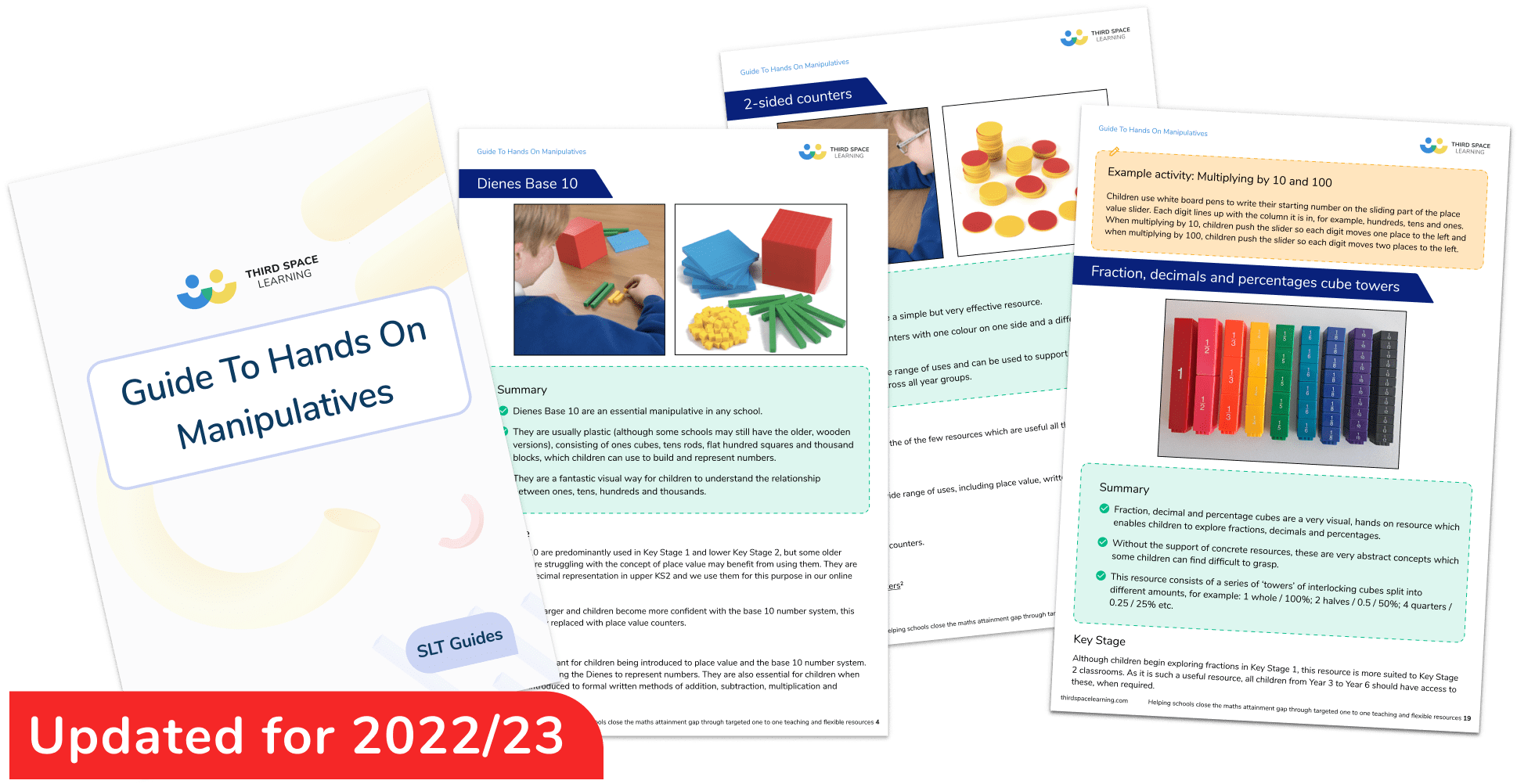How To Use Maths Manipulatives In Class To Make Real Breakthroughs With Your Students
Maths manipulatives have long been at the heart of a mastery approach to maths teaching and you’re likely to find at least one manipulative or another now in almost any UK maths classroom.
However, usage of these manipulatives can be patchy; after all, not all of these are fantastic for teaching all primary or secondary maths topics. To get the most out of your maths manipulatives, you need to know how and when to use them appropriately.
In this article, we take a look at some of the best manipulatives for teaching maths and how they can be used most effectively to support and extend children’s understanding and retention of information. We’ll also provide you with some practical examples of teaching fractions, one of the most challenging KS2 topics, through the effective use of manipulatives.
- What are maths manipulatives?
- The benefits of maths manipulatives
- When do students use manipulatives in maths?
- How to use maths manipulatives effectively
- Do’s and don’ts when using maths manipulatives
- The top 5 maths manipulatives every classroom should have
- The best maths manipulatives for teaching fractions
- Other recommended manipulatives
Guide To Hands On Manipulatives
Download our guide to hands on maths manipulatives. Includes 15 concrete resources every KS1 and KS2 classroom should have.
Download Free Now!What are maths manipulatives?
In maths manipulatives are concrete objects designed to help learners develop number sense and a deeper understanding of maths concepts by having something hands on to work with. Examples of manipulatives include counters, blocks, cubes, and even paper that you can handle physically. Maths manipulatives play an essential role in the concrete pictorial abstract CPA approach to maths mastery teaching and help students develop problem solving skills early on in their learning.
Specific examples of maths manipulatives include:
Maths manipulatives are sometimes referred to as concrete resources, which are designed to support children with their learning across the maths curriculum.
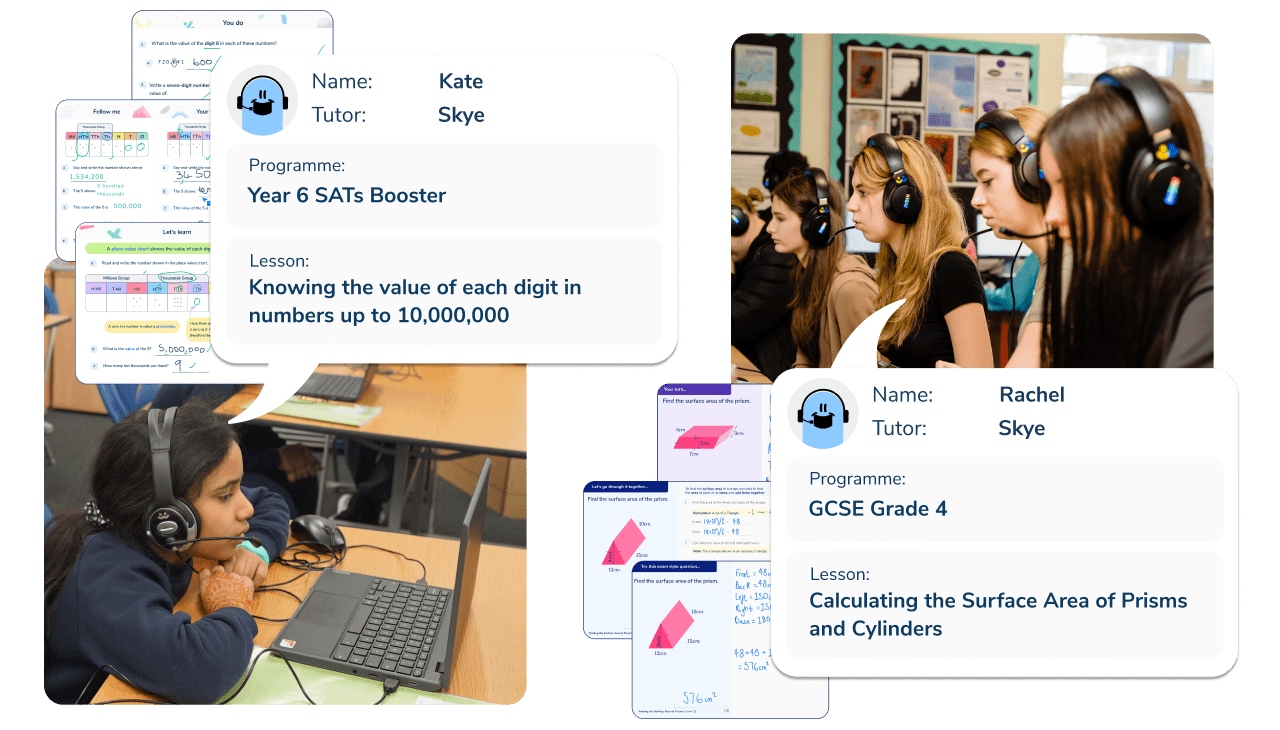
Meet Skye, the voice-based AI tutor making maths success possible for every student.
Built by teachers and maths experts, Skye uses the same pedagogy, curriculum and lesson structure as our traditional tutoring.
But, with more flexibility and a lower cost, schools can scale online maths tutoring to support every student who needs it.
Watch Skye in actionThe benefits of maths manipulatives
Many mathematical ideas are inherently abstract by nature and can be particularly challenging to grasp.
So in the past, students would be taught the algorithms to solve mathematical problems without fully understanding the underlying mathematical principles. While they were able to arrive at the correct answer, many didn’t understand how they got there. Consequently, many children struggled to internalise and retain mathematical knowledge.
The use of mathematical manipulatives provides young children, in their early childhood and beyond, with a hands-on, visual way of exploring even the most abstract of mathematical concepts. It allows students to physically hold and ‘see’ the maths with concrete materials and concrete objects to expand their conceptual understanding.
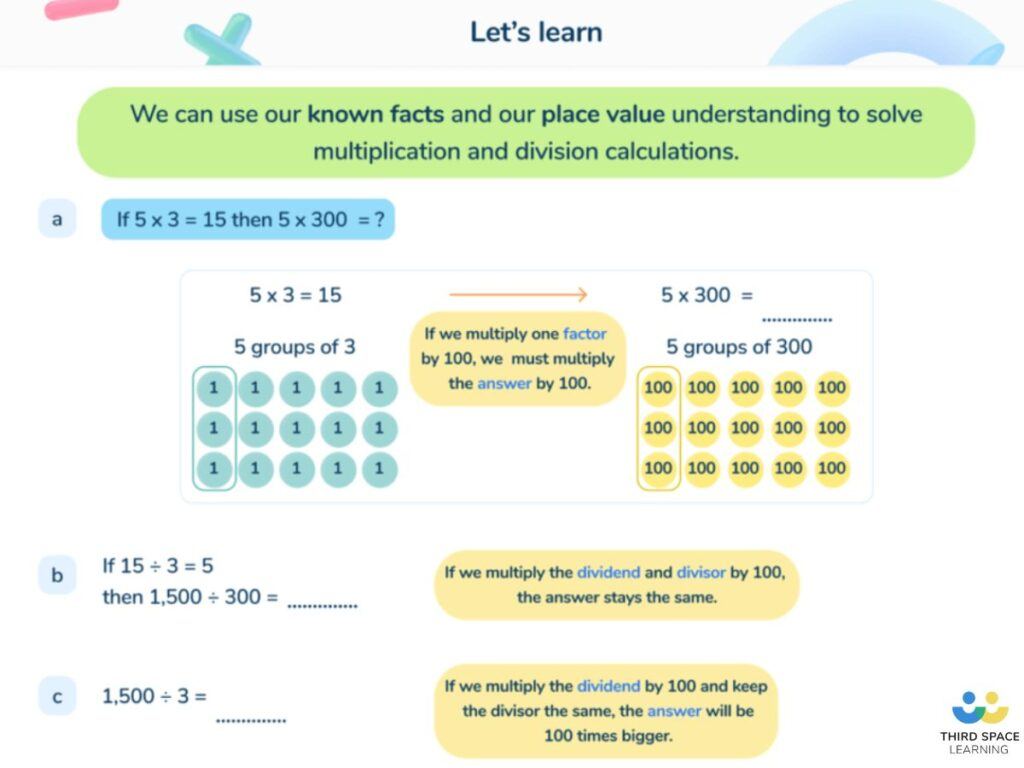
If you know you just want to grab a copy of one of our most popular resources ever, here’s the link to the list of the 15 best hands on manipulative examples and how to use them: Download the Ultimate Guide to Maths Manipulatives.
These practical resources eliminate the abstract element of maths, providing students with a much deeper understanding and confidence to apply their knowledge to different situations.
Concrete maths manipulatives provide the learner with a ‘window’ to make sense of the problem at hand by touching them, playing with them, and exploring the patterns and relationships. This makes a huge difference between understanding for depth or just for procedure.
Research has shown that teaching with physical manipulatives has a significant positive impact on learning in maths (Carbonneau, K.J., Marley, S.C. & Selig, J.P. 2013)
Certainly, the Asian-style model of mathematics teaching strongly advocates using manipulatives in the classroom, with the concrete pictorial abstract approach they’ve popularised.
When do students use manipulatives in maths?
Initially, maths manipulatives were seen as an aid for supporting children in early years and KS1 and there was almost a stigma about using these higher up the school. However, this misconception has recently disappeared, with manipulatives now being widely recognised as a useful tool for supporting students in both primary and secondary school.
The timing of the introduction of maths manipulatives in your school or classroom is less important compared with how you introduce them and the manipulatives you choose as a maths team to use. Consistency of manipulatives is important to start building children’s confidence with them.
How to use maths manipulatives effectively
Incorporating a range of manipulatives into your everyday practice is a key factor in ensuring you are teaching maths effectively. But before you think “Great – let’s just get out some practical resources each lesson and all pupils will succeed!”, it’s also about how you model the resource, how pupils use it, and how they relate what they are doing practically to the problem you’ve asked them to solve.
Here are the steps to take to support the effective usage of maths manipulatives in your lessons:
- Choose the appropriate manipulative for the concept and year group being taught. There should be a clear rationale for using any particular manipulative. For example, for column addition with lower KS2 children, you may choose to use base ten Dienes equipment. With slightly older children who are working with larger numbers, a more appropriate resource would be place value counters.
- Provide children with the opportunity to explore the manipulative. This helps them to build an initial understanding of the resource and how it could help them.
- Demonstrate and model how to use the resource as you work through a problem. Discuss with the children what is happening and the maths they are seeing. At this initial stage, it is worth linking the concrete resource to the abstract to ensure children understand the link between the manipulative and any mathematical ideas they represent. Make sure children have observed the resource being modelled before progressing to the next step.
- Provide children with further opportunities to work with the manipulative on similar questions. Continue to connect the resource to the abstract mathematical ideas by recording this alongside.
- It’s now time to move from the concrete to the pictorial stage of practice. Once children have a secure understanding of the maths taking place, encourage them to move on to recording what is happening in pictures. This pictorial step should again be alongside the abstract.
- Encourage students to answer questions without the manipulative or the pictorial representation. When this occurs, this will depend on the pupil. There shouldn’t be any expectation that all children in the class will move through these stages at the same time.
- Allow students to select their own concrete maths manipulative for a particular concept. This will enable your pupils to gain independence and a greater understanding of the task at hand.
Do’s and don’ts when using maths manipulatives
Maths manipulatives are a fantastic tool for supporting children with a wide range of maths concepts. However, for these tools to have an impact on children’s learning and understanding, they do need to be used purposefully and appropriately:
- CPD: Ensure all staff are provided with sufficient CPD to ensure they are making the best use of the resources available to them.
- Storage: Consider carefully how manipulatives will be stored in the classroom to ensure they are easily accessible to students and they are aware of what is available.
- Alternative or virtual manipulatives: Investigate alternative options if the budget is tight. Many resources can be created much more cheaply than purchasing them commercially. For example, using straws and bundles of straws as an alternative to purchasing expensive Dienes blocks, or making use of virtual manipulatives, which are freely available online.
- Avoid dependence: Although manipulatives are good, it is important to remember that they are a temporary scaffold, not something for children to rely on permanently. They should be taken away once children have achieved a greater depth of understanding of a topic.
- Let your pupils find out problems for themselves: Try to avoid over-modelling how to use the manipulatives, as opposed to giving your pupils to chance to figure it out for themselves. If you over-model, it may cause the class to mimic your modelling as opposed to actually having a full understanding of the task.
- Use equipment effectively: It’s all well and good using the practical equipment, but it needs to be used effectively and appropriately. If it’s not correctly used, it can in turn have a detrimental effect on your pupils as they won’t have a true understanding of how to use these.
Read more: What Is Variation Theory?
In our Third Space Learning online lessons, we use a variety of visuals to mirror concrete resources. These include manipulatives such as Dienes base 10, numicons, and more. Our aim is to provide children with resources they are already familiar with using in the classroom to deepen their mathematical understanding of topics.
The top 5 maths manipulatives every classroom should have
With the wide range of maths manipulatives available, knowing where to begin and when to start equipping a classroom with resources can be quite overwhelming. In an ideal world, every classroom would have all the manipulatives available.
However, with ever-tightening budgets, we know this isn’t possible. With this in mind, we have chosen to look at the 5 maths manipulatives we think every classroom should have.
1. 2-sided counters
This is one of the most diverse manipulatives to use and a useful resource for any classroom from EYFS to Key Stage 3. 2-sided counters are a great support for so many different maths topics across all year groups including: place value, written calculations, fractions, decimals, percentages, ratio and algebra.
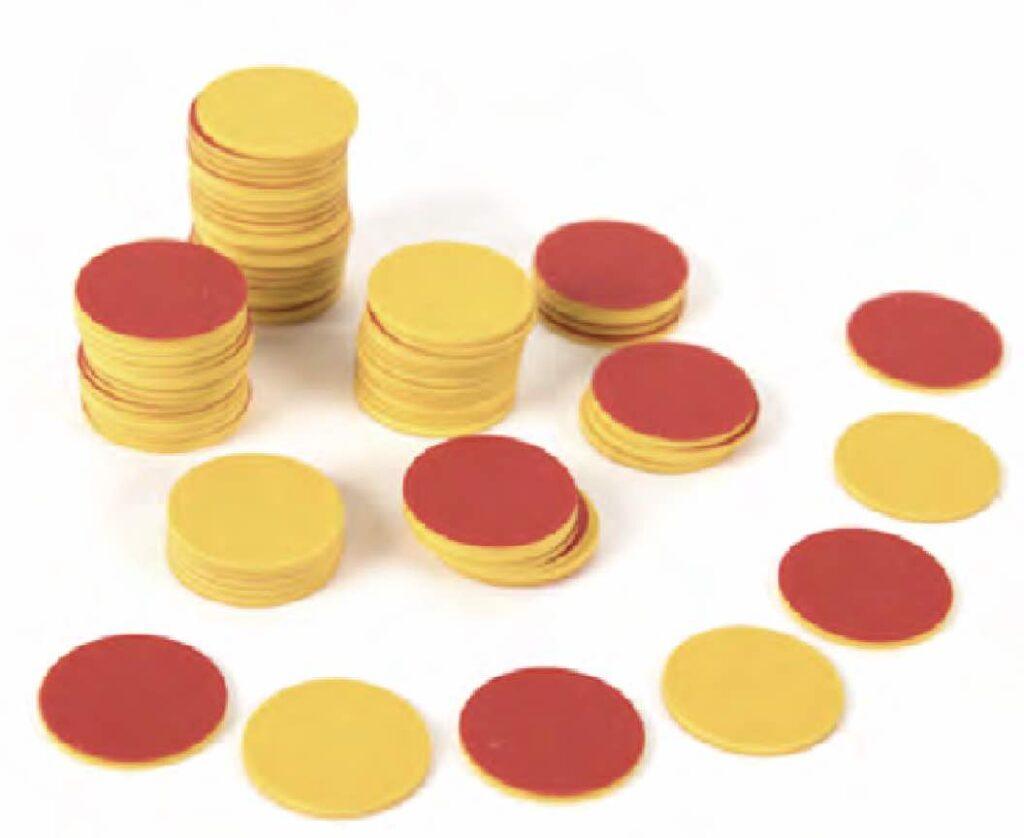
2. Dienes Base 10
Base 10 is a fantastic resource for supporting students in both Key Stage 1 and Key Stage 2. It’s great for helping children to understand the concept of place value (whole numbers for the younger children and decimal numbers for the older children). It also enables students to develop a deeper understanding of the formal written methods of addition, subtraction, multiplication, and division.
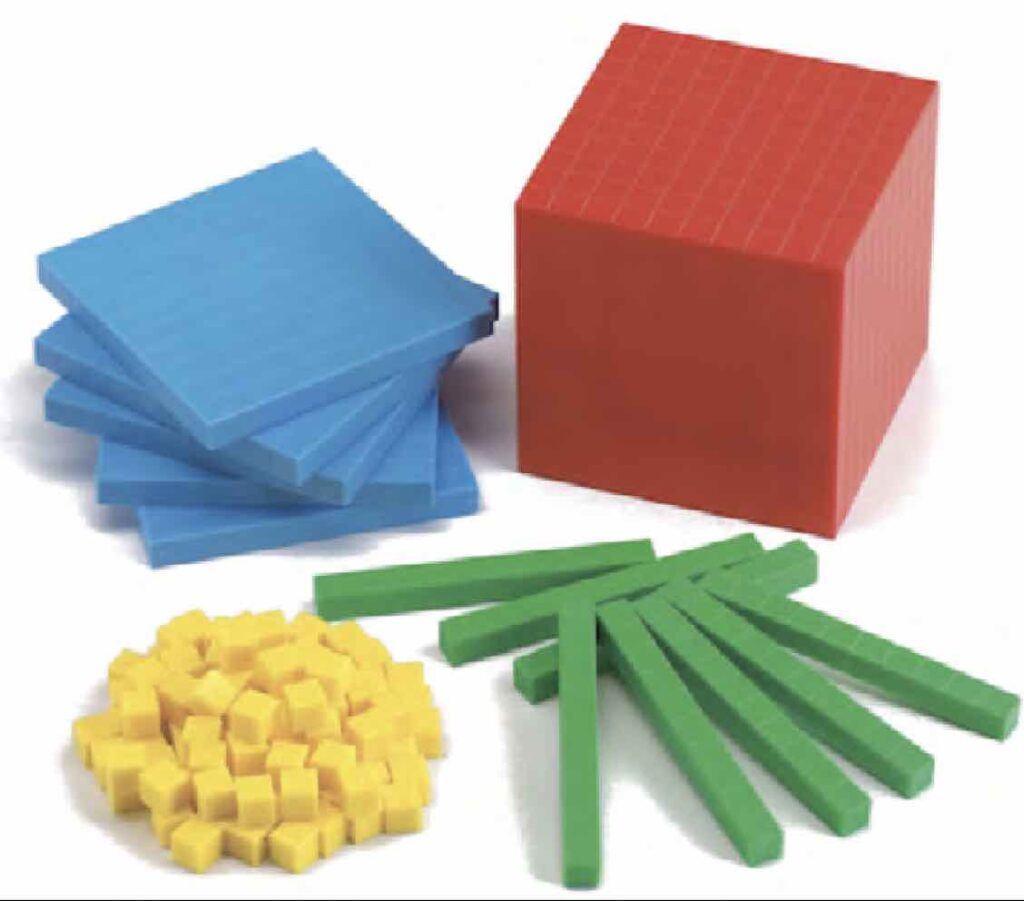
3. Place value counters
Place value counters are also a staple resource in any classroom, but are more suited to KS2 and KS3 classrooms. They have a similar use to Dienes base 10 and are particularly useful for place value and the 4 written methods, when numbers are larger, or when calculating with decimals. Place value counters have the added bonus of being a resource which can be made very cheaply if schools don’t have the budget to purchase class sets of place value counters. A much cheaper option is to buy cheap counters and a permanent marker to make your own. A good free alternative is to ask the children to collect any bottle tops. These can also be drawn on with permanent markers.
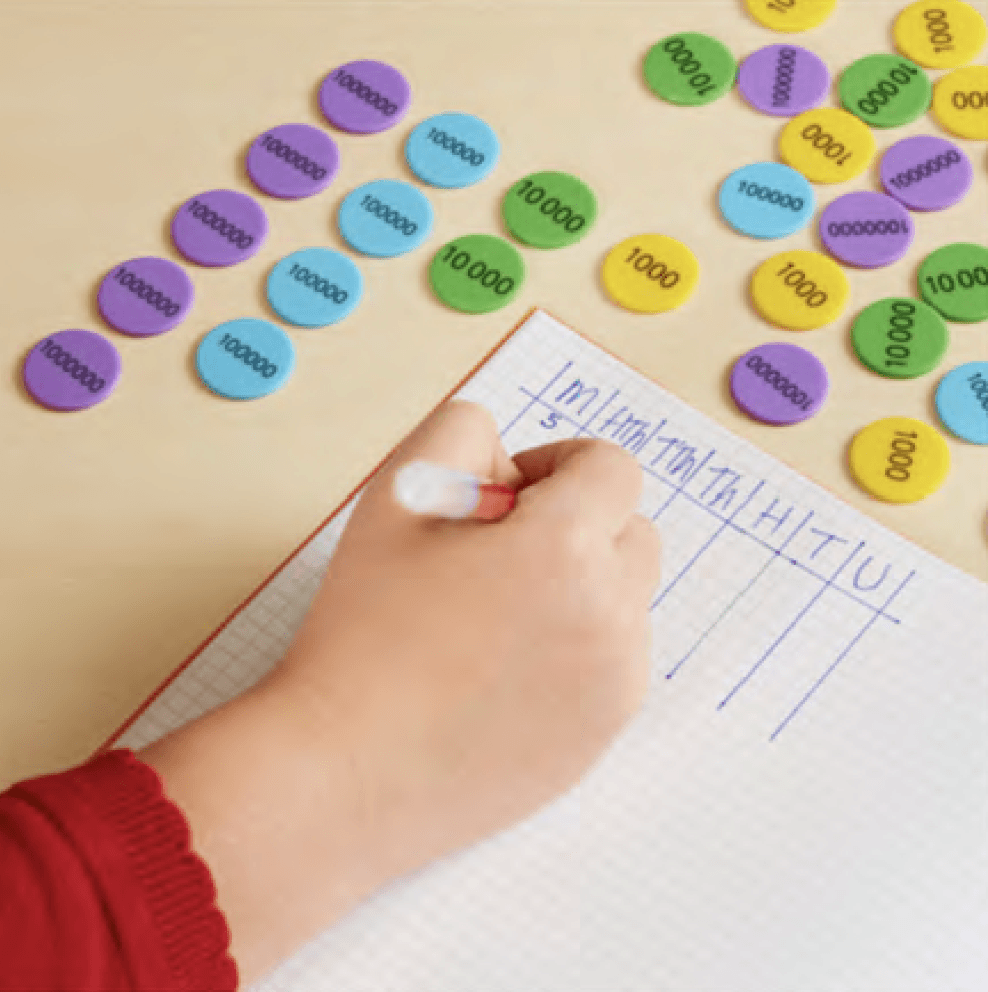
4. Rekenreks
Rekenreks are a relatively recent addition to many classrooms. They have grown in popularity in recent years due to Government funding and the ‘Mastering Number’ programme. A rekenrek consists of 20 beads in two rows of ten or 100 beads in ten rows of ten. They are an excellent visual resource for helping children to visualise numbers and improve their addition/subtraction strategies, such as doubling or finding near doubles.
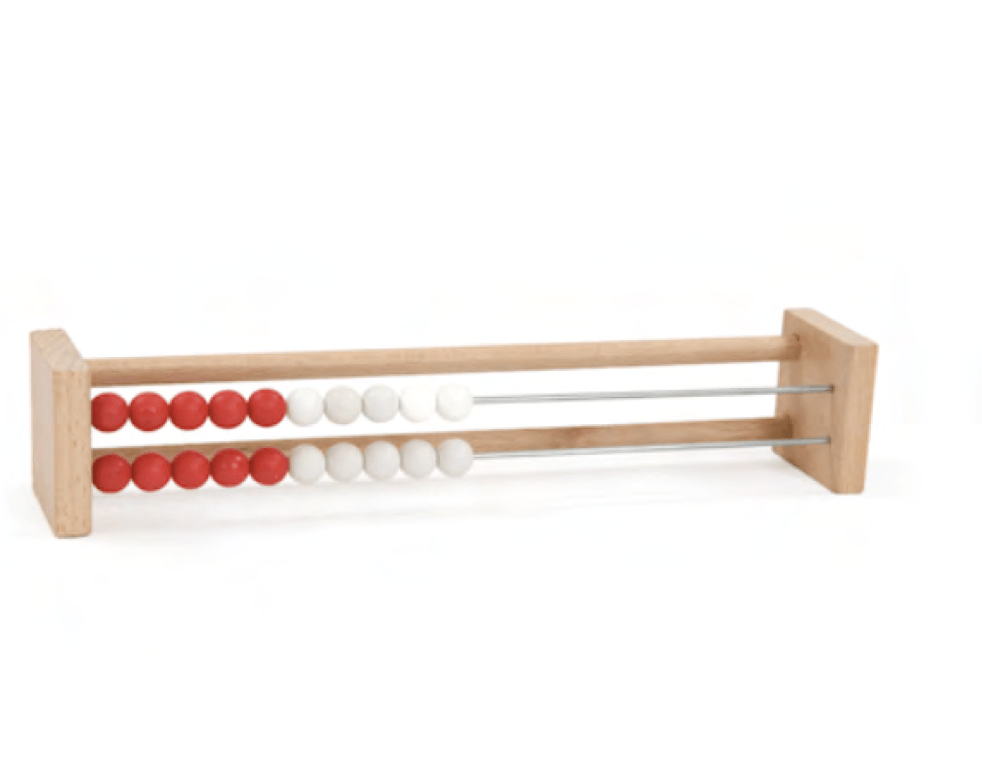
5. Tens frames
This is a resource many assume is aimed at only KS1 children, but is actually a useful resource in both KS1 and KS2. For younger children, they are useful for counting, place value and addition/subtraction of numbers within 10 and within 20. For older children, the resource can be used to help children understand decimal numbers, with the tens frame representing 1 and each section representing 0.1.
Explore other maths manipulatives:
- How Algebra Manipulatives Can Transform Engagement
- 10 Of The Best 100 Square Activities For Primary School
- What Is A Number Square? Explained For Primary School Teachers
The best maths manipulatives for teaching fractions
Fractions are a concept many children find challenging due to their highly abstract nature. In fact, here at Third Space Learning, fractions are the most popular choice of intervention topic after place value.
Maths manipulatives are the key to ensuring that children understand the maths taking place with any of the fractions concepts. They are also essential for ensuring children have a deeper understanding of the maths, rather than just learning a procedure to answer the question.
How to teach equivalent fractions with manipulatives
What to use:
- Fraction circles
How to use them:
- Fractions circles are an excellent resource for helping students to understand the concept of equivalent fractions.
- The circle pieces can be placed on top of each other, giving children a clear visual way of exploring fractions which are equivalent to each other.
- Having the opportunity to physically place the circles on top of each other is much better than the traditional fraction wall, which was a popular resource previously.
How to teach adding and subtracting fractions with manipulatives
What to use:
- Fraction cubes
How to use them:
- Students can use one set of fraction cubes if adding fractions which total a whole or less.
- When adding fractions greater than a whole, they will need more than one set. This is again a brilliant resource for helping children to ‘see’ this abstract concept.
- Children take the number of cubes in the question, for example, 3/5 + 4/5. They can quickly see they have 7/5.
- This can then be taken a step further, by using the cubes to work out that 5/5 are the same as 1 whole, so therefore the answer is 1 2/5.
How to teach multiplying fractions with manipulatives
What to use:
- Paper cut into rectangles
How to use them:
- Multiplication of fractions is another very abstract concept for children to understand. Folding paper is a brilliant way to help students understand the concept.
- Give a calculation to solve. For example ½ x 1/4,.
- Ask children to fold the paper in half, long ways. Then ask them to fold the paper into quarters the other way.
- This will make it clear for the children to see that ½ x ¼ is the same as ½ of ¼ or 1/4 of 1/2.
- If they colour in one section of the paper, they’ll find they have coloured in 1/8 of the rectangle, so ½ x ¼ or ½ of ¼ = 1/8.
How to teach fractions of amounts with manipulatives
What to use:
- Bar model and two-sided counters
How to use them:
- Two-sided counters are great for helping children identify unit and non-unit fractions of amounts.
- Give children a calculation to solve. For example, 3/8 of 24.
- Ask them to look at the denominator to work out what they need to divide their bar model into.
- In this example, the denominator is 8, so they need to split the bar into 8 sections.
- They then share out the 24 counters evenly between the 8 sections.
- Each section will now contain 3 counters, so they know that 1/8 of 24 is 3.
- If they turn over all the two-sided counters in three sections of the bar model, they’ll have turned over 3/8 of 24, so will be able to see that the answer to 3/8 of 24 = 9.
Read more: What Is A Bar Model?
How to teach converting between fractions and decimals with manipulatives
What to use:
- Fraction, decimal and percentages cubes
How to use them:
- Fraction, decimal and percentage cubes are a useful resource to enable students to clearly see the link between fractions of different sizes and their equivalent decimals and percentages.
- Children put them next to each other to provide a visual aid when identifying different fractions and their corresponding decimals
Other recommended manipulatives
Numicon
Numicon consists of different coloured, flat, plastic shapes, with each shape representing numbers from 1 to 10. They are a useful resource for all ages and can be used for a wide range of concepts including: place value, written calculations, fractions, decimals and percentages.
Bead strings
Bead strings are more commonly found in Key Stage 1 classrooms, but can be beneficial for both Key Stage 1 and Key Stage 2 students. They are strings of 10, 20, 50 or 100 white and red beads, which are grouped together into fives or tens. They can be used to teach a range of concepts, including: addition/subtraction, rounding, negative number, fractions, ratio and proportion.
Cuisenaire rods
Cuisenaire rods are plastic or wooden and are colour coded depending on their size. These are another great resource for teaching a wide range of concepts, including: number bonds, fractions, decimals, scaling and ratio.
Place value sliders
This is a great resource for helping children to understand the concept of digits changing value when multiplied by 10, 100 and 1000. They consist of columns, labelled as 1000, 100, 100, 10th, 100th and 1000th. Children write a number on a wipe clean strip, which is pulled to the left when multiplying and to the right when dividing.
Geoboards
This resource is more suited to Key Stage 2 pupils. They are square boards made of word or plastic , with small pegs on the surface. Students are able to stretch rubber bands over the pegs, to make different shapes. They are a great way to explore spatial relationships and geometric concepts.
Playing cards
These are a cheap resource to buy for the classroom. They are great for playing a wide range of maths games, which are good for bringing enjoyment and motivation to the maths lessons. They are also useful for supporting children to understand a range of concepts, including: place value, addition/subtraction, fractions and ratio.
Looking for more maths mastery resources?
- White Rose Maths Hub: How To Find The Resources You Need
- Maths Mastery Toolkit for Year 1 to Year 6
- Year 6 Word Problems and How To Solve Them Using Bar Modelling Techniques
A maths manipulative is any resource a student can physically hold and manipulate to explore a range of maths concepts. Dienes base 10 are an example of this. They consist of blocks representing 1, 10, 100 and 1000. The different sizes are designed to support children in understanding place value and applying this to other areas of maths, such as addition and subtraction.
The purpose of manipulatives is to help students understand the more abstract ideas in maths. Once children can ‘see’ the maths taking place, they develop a much deeper understanding, which helps them to apply their knowledge to other situations and retain what they have learnt.
Manipulatives and concrete resources are both tools used in maths to help students grasp mathematical concepts. While maths manipulatives are specifically designed for supporting the learning of maths, concrete resources refer to any resources used to support maths, but are not necessarily designed for that purpose. This includes things such as straws or bottle tops used for teaching place value.
DO YOU HAVE STUDENTS WHO NEED MORE SUPPORT IN MATHS?
Skye – our AI maths tutor built by teachers – gives students personalised one-to-one lessons that address learning gaps and build confidence.
Since 2013 we’ve taught over 2 million hours of maths lessons to more than 170,000 students to help them become fluent, able mathematicians.
Explore our AI maths tutoring or find out about primary maths tutoring for your school.
